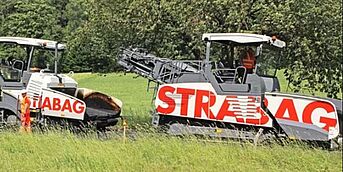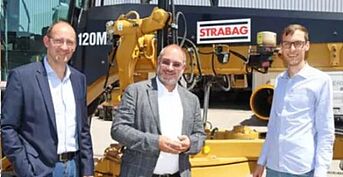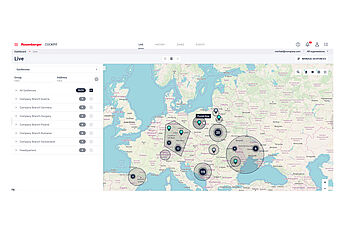STRABAG SE - A success story in the world of telematics
Great optimisation potential through current machine data at STRABAG
As one of the largest European construction groups, Strabag SE operates a machinery and vehicle fleet that comprises around 200,000 individual items.
Step by step, a telematics system is now being implemented with which the most important machine data is currently available.
A complex project in which Rosenberger Telematics was able to position itself as a competent partner and for which the rollout started about a year ago.
A strong partner
With a dense network of subsidiaries in many European countries and on other continents, Strabag SE covers all areas of the construction industry and employs more than 75,000 people. Within the Group, Strabag BMTI is responsible for the internal scheduling, rental, maintenance, repair, and overhaul of all construction machinery and vehicles. For this purpose, Strabag BMTI has approx. 150 workshops across all countries and employs approx. 2,500 people. Around 600 service vehicles support the colleagues on the construction sites in the areas of maintenance and repair. With regard to the telematics project now underway, we asked Michael Heiden, MBA (Head of Quality Management, IT Coordination and Corporate Development, Strabag BMTI) and Christian Meschnig. (Chief Executive Officer, Rosenberger Telematics GmbH) for an interview.
Mr. Heiden, can you give us a brief overview of the development of the telematics project?
Heiden:
“We started to deal with the topic of telematics in principle about 10 years ago. For many years, we pushed ahead with our own development, which pursued the goal of having as much data available as possible. However, this approach did not show the expected success. Therefore, when I was entrusted with the responsibility for this project in 2017, I first spent a few months familiarizing myself with the systems on the market. One of the main problems was scalability, as our desire to incorporate several thousand devices often caused problems with the underlying database and software performance. In addition, our hierarchy levels and organizational units had to be mapped with their respective access rights. The requirement was and still is that we want to have a manufacturer-independent system with which we can present all our construction machinery, equipment, and commercial vehicles in one portal – and without having to enter different manufacturer portals. In contrast to the first approach, where we wanted to collect as much data as possible, we have now focused on three central pieces of information: Position, load and fuel consumption. Around the same time, the construction equipment industry agreed on the AEMP 2.0 interface, which is based on ISO 15143-3, through which manufacturers provide a lot of data in a specific format. Of these, as already mentioned, we use the three groups of position, utilization, and fuel consumption.”
In cooperation with Rosenberger Telematics, we now have access via these interfaces to the majority of our machines, which we have been equipping with manufacturer telematics since 2015. Wherever no telematics is available from the manufacturer, we retrofit very selectively – depending on the equipment group – with certain products from Rosenberger Telematics. Always with the aim of getting the three values mentioned from the machine. We currently have almost 3,000 devices in the system and expect a strong increase because commercial vehicles and small devices are now also increasingly being integrated. I suspect that we will break the 10,000 mark within the next two years. Our goal is to start by equipping mainly the large appliances with a telematics unit. Depending on the definition, we are talking about up to 18,000 key machines in 16 countries with a focus on Europe. Of course, we also want to equip smaller machines accordingly. I would also like to mention that the basis for the use of the systems is of course an agreement with the works council.
How did the cooperation with Rosenberger Telematics start?
Heiden:
"I became aware of the system through the company's installation app, because one of the central problems in the early phase was the non-existent quality assurance when installing the telematics units. As a result, many units did not transmit or only transmitted incorrectly. We held the first talks in autumn 2017, and after an evaluation phase, we decided on Rosenberger Telematics in October 2018. We then spent half a year working on company-specific adaptations for Strabag and have been rolling out the system since summer 2019."
Meschnig:
"Regarding the service app I mentioned, I would like to add that it is a service app. We developed it early on because complaints due to improperly performed installations at external workshops often ended up with us as the manufacturer. The app is modular and flexible and can therefore be adapted quickly. The technician carrying out the installation is guided step by step through the installation. In the background, the data exchange between the telematics or the machine and the customer's server already begins. This makes it possible to carry out initial checks, such as the correctness of the inventory number or whether an unregistered telematics unit has already been installed. Photos of the installation details and an overall view of the machine are implemented in the documentation and serve to build up the knowledge database or enable further checks. The central element in the process is the fully automated diagnosis when the machine is running and the GPS signal is received. This diagnosis is the final confirmation of the correct installation.
If everything is completed positively, the report is confirmed and checked by an inspector from the customer. Finally, the document of the successful installation is added to the machine documents fully automatically as a PDF. The advantage of this solution: we can define separate installation instructions for each product, in different national languages and designed differently for different customers. The app is available to internal and external specialist workshops, whereby the respective technician is invited by the customer and from this point on has the authorization to install certain products. This authorization can also be withdrawn again.
Can you briefly outline the components of the telematics system?
Meschnig:
“The hardware side is divided into different product groups. The spectrum ranges from energy-autonomous applications for containers or trailers to solutions for trucks, cars, and service vehicles to the line for construction machinery and heavy equipment called ROBUSTO. The data of these product groups are combined in a software called Commander. Commander collects and harmonizes the various protocols and signals from the individual manufacturer systems, regulates user access authorizations and device management, integrates the installation app and provides visualization in the interface. Via an interface to the Strabag master data, we also take over the cost center information or the classification in the construction equipment group list when creating a new machine. These are built up in a structured and fully automated way in the Commander and define the access rights.
We have twelve years of experience in telematics and are part of the Rosenberger Group, which, as a Bavarian family-owned company with more than 11,300 employees, has been a leading global manufacturer of connection solutions (connectors) in high-frequency and fibre-optic technology for over 60 years. From our in-house telematics hardware, which is produced exclusively in Europe within the Rosenberger Group, and our software, we develop highly flexible overall solutions that impress with their clarity and ease of use.”
What technology is used in the small devices?
Meschnig:
“The central question here is: What is the value of the information, or what does the information cost me in relation to the device costs? Wherever the investment in a telematics system is not economical, we use Bluetooth beacons. These connect the small device over a distance of up to 100 m with the nearest telematics system. This can be installed in a construction machine, a truck or a service vehicle. The telematics system collects the positions of the small devices in the vicinity via Bluetooth and sends them to the server. Incidentally, this does not only apply to small devices, but also to attachments. It happens all the time that something is left behind on the construction site.”
From what size of a construction company does a telematics solution make sense?
Meschnig:
“We look after numerous companies in construction, and smaller construction companies only have two or three devices recorded. Regardless of whether it is a corporate group or a smaller construction company: at the end of the month, there is a new version of Commander with the latest features. After all, it's not only the big companies that have good ideas; small firms also contribute valuable suggestions time and again. Perhaps a word on the cost side: the financial outlay is made up of the one-time investment in the hardware and the ongoing operation with monthly licenses. Separately, there may be expenses for special services, such as training or installation, if requested by the customer.”
What concrete advantages do you expect from the telematics system in ongoing operation?
Heiden:
“The focus is clearly on optimizing internal operations. I think that next year certain areas will already be able to use this telematics information as a basis for internal scheduling and thus have new possibilities to optimize the use of equipment. In practice, this means fewer machines for the same number of construction sites. Optimization is already taking place, of course, but there is still a lot of potential here. Another important point, in my view, is to make better use of the maintenance intervals. If I have information about the operating hours, I can of course optimize my maintenance cycles. In addition, we will get more information about the actual utilization of all devices. I think that in the future, real performance data will also be available, for example on the actual earth moving volume of the individual machines. Last but not least, telematics is a pre-system that other systems will rely on. This results in synergies that form a basis for further digitization steps. One example is the new system Workshop 4.0, which we are currently working on. In Austria, all our service vehicles are already equipped with telematics. From autumn onwards, this system will be used in the first workshop with the aim of optimizing workshop processes. Based on the known position of the vehicle, the route to the next job can be optimized. And last but not least: our machine park has grown massively in the last three years, with almost the same size of team. In the end, we will be able to service more machines with a similar number of employees.”




